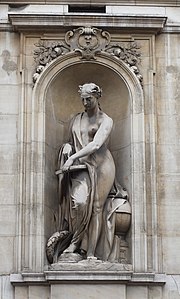
The Grand-Place or Grote Markt is the central square of Brussels, Belgium. It is surrounded by opulent Baroque guildhalls of the former Guilds of Brussels and two larger edifices; the city's Flamboyant Town Hall, and the neo-Gothic King's House or Bread House building, containing the Brussels City Museum. The square measures 68 by 110 metres and is entirely paved.

The Royal Theatre of La Monnaie is an opera house in central Brussels, Belgium. The National Opera of Belgium, a federal institution, takes the name of this theatre in which it is housed—La Monnaie in French or De Munt in Dutch—referring both to the building as well as the opera company. As Belgium's leading opera house, it is one of the few cultural institutions to receive financial support from the Federal Government of Belgium. Other opera houses in Belgium, such as the Vlaamse Opera and the Opéra Royal de Wallonie, are funded by regional governments.

The Senne or Zenne is a small river that flows through Brussels, Belgium. Its source is in the village of Naast near the municipality of Soignies. It is an indirect tributary of the Scheldt, through the Dyle and the Rupel. It joins the Dyle at Zennegat in Battel, north of the municipality of Mechelen, only a few hundred metres before the Dyle itself joins the Rupel.

The City of Brussels is the largest municipality and historical centre of the Brussels-Capital Region, as well as the capital of the Flemish Region and Belgium. The City of Brussels is also the administrative centre of the European Union, as it hosts a number of principal EU institutions in its European Quarter.

The Hotel Métropole is a currently closed five-star luxury hotel in central Brussels, Belgium. It was built in 1872–1874 in an eclectic style with neo-Renaissance and Louis XVI influences. The hotel opened in 1895 and was the only 19th-century hotel still in operation in Brussels, until it closed due to the COVID-19 pandemic in April 2020, after 125 years of continuous operation. The hotel had 251 rooms and 22 spacious suites. It was sold in 2022 and the new owners announced plans to restore it and reopen it in 2025.

The covering of the Senne was the covering and later diverting of the main river of Brussels, Belgium, and the construction of public buildings and major boulevards in its place. Carried out between 1867 and 1871, it is one of the defining events in the history of Brussels.

Saint-Géry Island or Sint-Goriks Island was the largest island in the river Senne in Brussels, Belgium. It was named after Saint Gaugericus of Cambrai, who according to legend, built a chapel there around 580. It ceased to exist as an island when the Senne was covered over in the late 19th century, and a former covered market, the Halles Saint-Géry/Sint-Gorikshallen, was built in its centre. Since the late 20th century, this building has been rehabilitated as an exhibition space.

The Halle Gate is a former medieval city gate and the last vestige of the second walls of Brussels, Belgium. Built between 1381 and 1383, it was heavily restored in the 19th century in its current neo-Gothic style by the architect Henri Beyaert. It is now a museum dedicated to the medieval City of Brussels, part of the Royal Museums of Art and History (RMAH).
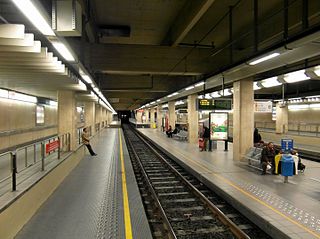
Bourse - Grand-Place (French) or Beurs - Grote Markt (Dutch) is a premetro station in central Brussels, Belgium, located under the Boulevard Anspach/Anspachlaan, next to the Place de la Bourse/Beursplein and the former Brussels Stock Exchange, after which it is named. It is also located metres from the Grand-Place/Grote Markt.

The Boulevard Anspach (French) or Anspachlaan (Dutch) is a central boulevard in Brussels, Belgium, connecting the Place de Brouckère/De Brouckèreplein to the Place Fontainas/Fontainasplein. It was created following the covering of the river Senne (1867–1871), and bears the name of Jules Anspach, a former mayor of the City of Brussels.

The Temple of the Augustinians, alternatively the Church of the Augustinians in Brussels, Belgium, was a Brabantine Baroque-style church designed and built from 1621 to 1642 by the architect Jacob Franquart for the Augustinians order. It was located on the Place de Brouckère/De Brouckèreplein in central Brussels until its demolition in 1893–94. Its facade's masonry, however, was preserved, being disassembled and reconstructed as the facade of the Church of the Holy Trinity in Ixelles.
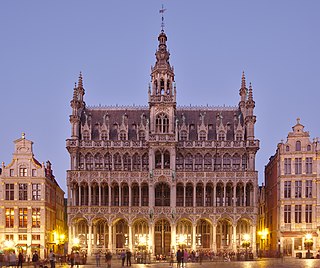
The Brussels City Museum is a municipal museum on the Grand-Place/Grote Markt of Brussels, Belgium. Conceived in 1860 and inaugurated in 1887, it is dedicated to the history and folklore of the City of Brussels from its foundation into modern times, which it presents through paintings, sculptures, tapestries, engravings, photos and models, including a notable scale-representation of the town during the Middle Ages.

The Place de Brouckère or De Brouckèreplein (Dutch) is a major square in central Brussels, Belgium. It was created following the covering of the river Senne (1867–1871), replacing the Temple of the Augustinians, which was demolished in 1893. It is named in honour of Charles de Brouckère, a former mayor of the City of Brussels and professor at the Free University of Brussels, who played a great political role during the Belgian Revolution of 1830. The square measures approximately 50 by 350 metres and is nearly entirely paved.

The Place de la Bourse (French) or Beursplein (Dutch), meaning "Stock Exchange Square", is a major square in central Brussels, Belgium. It was created following the covering of the river Senne (1867–1871). The former Brussels Stock Exchange building, of which it takes its name, is located on this square. It is served by the premetro station Bourse/Beurse on lines 3 and 4.

The Boulevard Adolphe Max or Adolphe Maxlaan (Dutch) is a central boulevard in Brussels, Belgium. It was created following the covering of the river Senne (1867–1871), and bears the name of Adolphe Max, a former mayor of the City of Brussels.

The Central Boulevards are a series of grand boulevards in central Brussels, Belgium. They were constructed following the covering of the river Senne (1867–1871), as part of the major urban works by the architect Léon Suys under the tenure of the city's then-mayor, Jules Anspach. They are from south to north and from west to east: the Boulevard Maurice Lemonnier/Maurice Lemonnierlaan, the Boulevard Anspach/Anspachlaan, the Boulevard Adolphe Max/Adolphe Maxlaan, and the Boulevard Émile Jacqmain/Émile Jacqmainlaan.
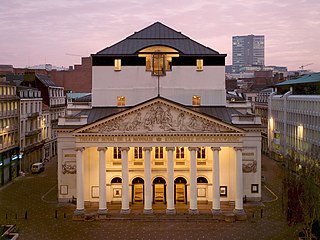
The Place de la Monnaie or Muntplein (Dutch), meaning "Mint Square", is a major square in central Brussels, Belgium. The Royal Theatre of La Monnaie, home to the National Opera of Belgium, is located on this square. It is served by the metro and premetro station De Brouckère on lines 1, 3, 4 and 5.

The Place Fontainas (French) or Fontainasplein (Dutch) is a square in central Brussels, Belgium. It was created following the covering of the river Senne (1867–1871). It is named in honour of André-Napoléon Fontainas, a former mayor of the City of Brussels.

The Place Anneessens (French) or Anneessensplein (Dutch) is a square in central Brussels, Belgium. It is named in honour of François Anneessens, dean of the Nation of St. Christopher, who was beheaded on the Grand-Place/Grote Markt during a period of uprisings within the Austrian Netherlands.

The Anspach Fountain is an eclectic-style fountain-obelisk erected between 1895 and 1897 in the centre of the Place de Brouckère/De Brouckèreplein in Brussels, Belgium. Designed by the architect Charles-Émile Janlet, it is dedicated to the memory of Jules Anspach, a former mayor of the City of Brussels.
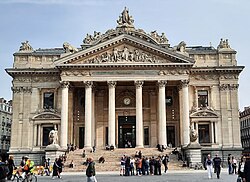



![Interior pediment with caryatids by Auguste Rodin and Antoine van Rasbourg [nl] Bruxelles, Palais de la Bourse et Cariatides, journees du Patrimoine - panoramio.jpg](http://upload.wikimedia.org/wikipedia/commons/thumb/b/b7/Bruxelles%2C_Palais_de_la_Bourse_et_Cariatides%2C_journ%C3%A9es_du_Patrimoine_-_panoramio.jpg/170px-Bruxelles%2C_Palais_de_la_Bourse_et_Cariatides%2C_journ%C3%A9es_du_Patrimoine_-_panoramio.jpg)



